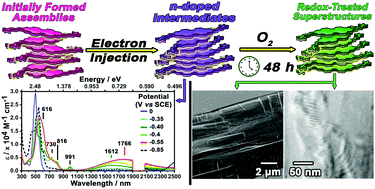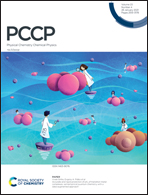How to reprogram the excitonic properties and solid-state morphologies of π-conjugated supramolecular polymers†‡
Abstract
The development of supramolecular tools to modulate the excitonic properties of non-covalent assemblies paves the way to engineer new classes of semicondcuting materials relevant to flexible electronics. While controlling the assembly pathways of organic chromophores enables the formation of J-like and H-like aggregates, strategies to tailor the excitonic properties of pre-assembled aggregates through post-modification are scarce. In the present contribution, we combine supramolecular chemistry with redox chemistry to modulate the excitonic properties and solid-state morphologies of aggregates built from stacks of water-soluble perylene diimide building blocks. The n-doping of initially formed aggregates in an aqueous medium is shown to produce π–anion stacks for which spectroscopic properties unveil a non-negligible degree of electron–electron interactions. Oxidation of the n-doped intermediates produces metastable aggregates where free exciton bandwidths (ExBW) increase as a function of time. Kinetic data analysis reveals that the dynamic increase of free exciton bandwidth is associated with the formation of superstructures constructed by means of a nucleation-growth mechanism. By designing different redox-assisted assembly pathways, we highlight that the sacrificial electron donor plays a non-innocent role in regulating the structure–function properties of the final superstructures. Furthermore, supramolecular architectures formed via a nucleation-growth mechanism evolve into ribbon-like and fiber-like materials in the solid-state, as characterized by SEM and HRTEM. Through a combination of ground-state electronic absorption spectroscopy, electrochemistry, spectroelectrochemistry, microscopy, and modeling, we show that redox-assisted assembly provides a means to reprogram the structure–function properties of pre-assembled aggregates.

- This article is part of the themed collection: 2021 PCCP HOT Articles


 Please wait while we load your content...
Please wait while we load your content...